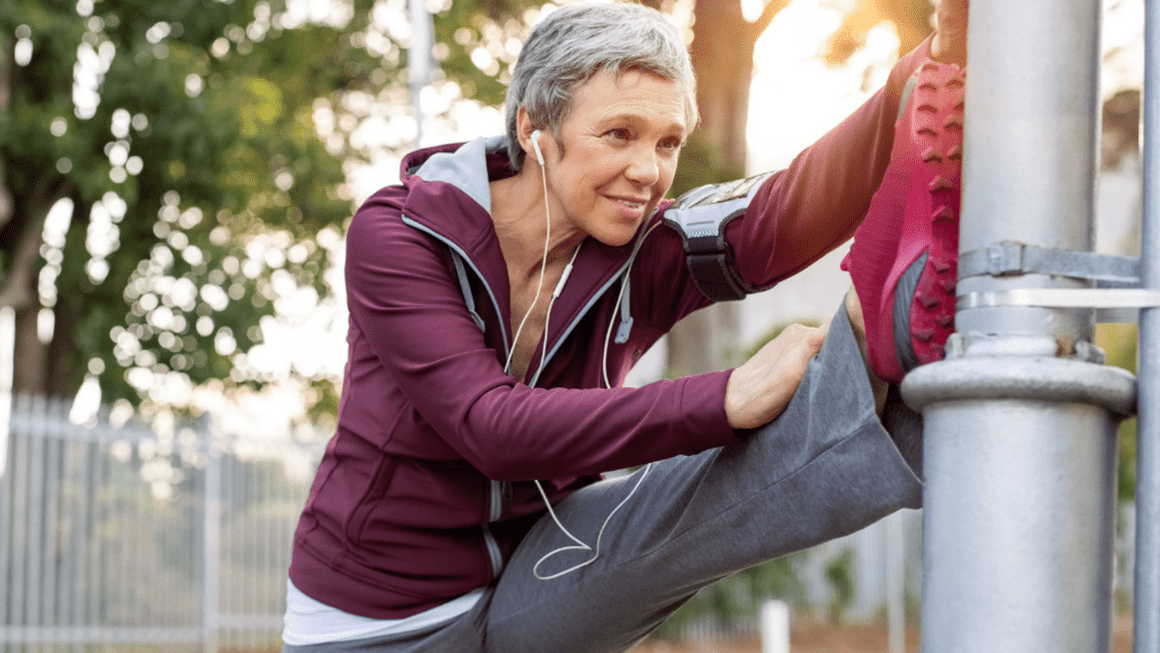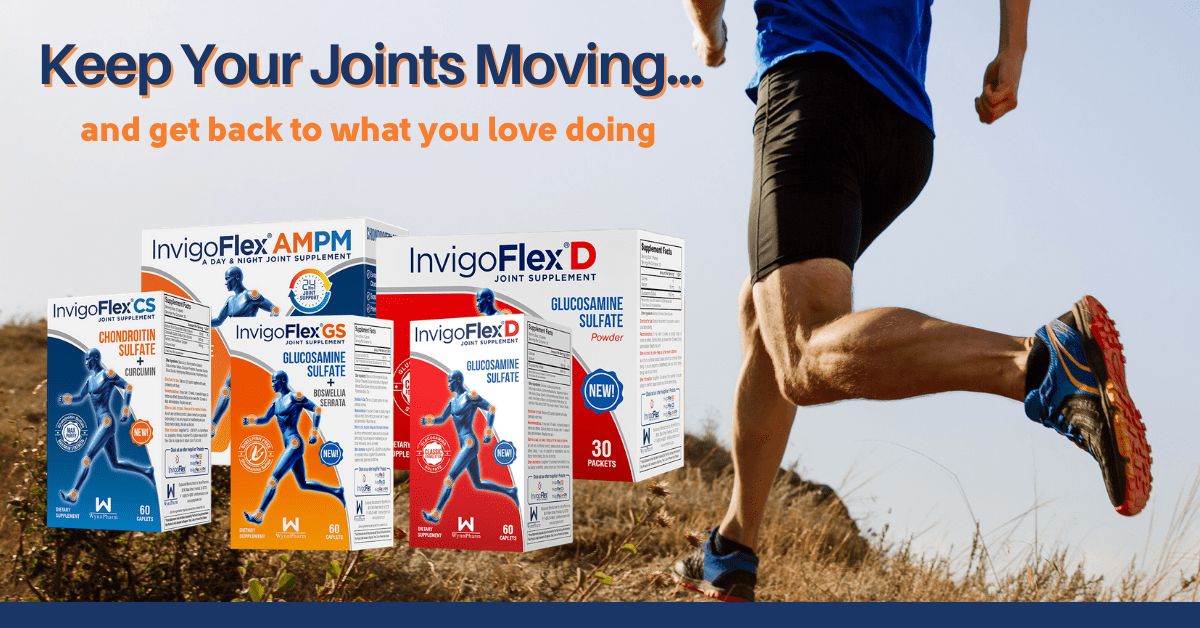At Home Exercises for your Joints
Posted by InvigoFlex® on 15th Nov 2020
Exercise for those suffering from joint discomfort seems odd at first, but optimal joint health depends on it. Beyond choosing the right supplement, daily or weekly exercises for your joints can help reduce stiffness and inflammation. While gyms or even parks may be inaccessible during this pandemic, there are plenty of exercises you can do from the comfort of your own home to help keep those joints moving.
Walking
While not really meant for in your home, walking routines can be done around your neighborhood. The beauty with walking is you don’t need that much space. Also, this is one of the best ways to begin an active routine. Walking is considered a low-impact activity that can help relieve arthritis pain, stiffness and even swelling. It uses the whole body with various muscle groups working at the same time to help with range of motion issues, balance, and building strength on weaker joints. There is no specific amount of time that you should walk for, but we would recommend starting slow and gradually increasing the time and distance. Find a plan or a route that works best for you and your joints. Be mindful of inclines or declines but don’t be afraid to incorporate them into your routine. They are great for adding in more resistance. If you have pain or weakness on one side of your joints such as a hip or in one of your knees, don’t be afraid to incorporate a walking pole to give more balance and stability. This will help in longer distances. If walking is too painful, water therapy can be an option for those with pools. The buoyancy can help remove the pressure directly from the joints.
Leg Exercises
If you have ever done concentrated exercises for your legs you know that it can be tough and painful, especially with joint issues. However, these exercises are not to blame. Often pain and discomfort is felt due to a lack of mobility and strength in the hips or ankles. These body parts are crucial for the knee joint during leg exercises as they dictate how much stress and strain the knee can handle. Muscles in the quads, hamstrings, hip, adductors, and calves all have a direct impact on how your joints feel. That is why simple leg exercises should be incorporated in your daily or weekly routine to help with joint discomfort. According to healthline.com, below are some common exercises you can do from home to help with knee pain.
- Leg raise (lying) - Lie flat on your back on the floor or bed with your arms at your sides, toes up. Keep your leg straight while tightening your leg muscles, and slowly lift it several inches. Tighten your stomach muscles to push your lower back down. Hold and count to 5, then lower your leg as slowly as possible. Repeat, then switch to the other leg. Start with one set of four for each leg. This exercise strengthens the quadriceps, which are the large muscles on the fronts of your thighs that attach to your knee joints.
- Hamstring stretch (lying) - Lie on the floor or bed with both legs bent. Slowly lift one leg, still bent, and bring your knee back toward your chest. Link your hands behind your thigh, not your knee, and straighten your leg. Pull your straight leg back toward your head until you feel the stretch. Hold for 30 to 60 seconds, then slowly bend your knee and lower your leg back to the floor. Perform the stretch 1 time on each leg. This exercise stretches and strengthens your hamstrings, which are the muscles on the backs of the thighs that attach to the knees.
- Half-squat - Stand with your feet shoulder-distance apart and stretch your arms out in front of you. Slowly bend your knees until you’re in a half-sitting position. Hold on to a chair for balance, if necessary. Keep your back straight and chest lifted — don’t lean forward. With your feet flat on the floor, hold the position for 5 seconds, then slowly stand back up. There should be no pain while performing this exercise. Do 10 repetitions, and slowly work up to three sets of 10. This exercise strengthens the muscles on the fronts and backs of your thighs, along with the gluteus.
- One-leg dip - Stand between two chairs and hold on to them for balance. Lift one leg about 12 inches and hold it out in front of you. Slowly, keeping your back straight, bend the other leg and lower your body a few inches, as if you were about to sit in a chair. Don’t cross the lifted leg in front of the bent leg. Hold for 5 seconds and straighten back up. Repeat and switch legs. Start with one set of four leg dips for both legs, and slowly work up to three sets. This exercise strengthens the muscles on the fronts and backs of your thighs, as well as your buttocks.
- Leg stretches - Sit on the floor with both legs out straight. Stabilize yourself with your hands on either side of your hips, and keep your back straight. Slowly bend one knee until it feels stretched, but not until it becomes painful. Hold your leg in that position for 5 seconds, then slowly straighten your leg out as far as you can, again holding for 5 seconds. Repeat and switch legs whenever one begins to tire, 10 times. This exercise also strengthens the quadriceps.
Hand Exercises
Dealing with hand joint pain is very frustrating and can make it difficult doing everyday tasks. Your hand is made up of various tendons which are more susceptible to pain and swelling. Engaging in specific hand exercises can increase the blood flow and help strengthen the muscles around the joints. According to Creakyjoints.org and Karen Jacobs, EdD, OT, OTR, CPE, FAOTA, an occupational therapist who works with arthritis patients and a clinical professor at Boston University, below are some common exercises you can do from home to help with hand pain.
- Make a fist - Start with your fingers straight and then slowly bend your hand into a fist. Make sure your thumb is on the outside of your hand. Don’t squeeze too tightly, then straighten again.
- Bend your digits - Stretch your hand in front of you, palm up. Then take each finger and move it very slowly to the center of your palm. Hold it, then straighten.
- Thumb bends - “Sometimes people have more issues with their thumb,” Jacob says, so when doing the digit exercise for your thumb, “bend it toward your palm—if you can reach your pinky that’s cool, and if you can’t, go as far as you can, hold and then start again.”
- Make a C or an O - Move your fingers like you’re going to grab a little ball, and try to form a shape of a C or an O. Go as far as you can (an O would be making a complete circle with your fingers and thumb). Straighten your fingers and repeat.
- Thumbs up - Have your hand in a loose fist with the pinky side of your hand on a table. Then point your thumb to make the thumbs up sign, put it down, and repeat.
- Finger lifts - With your palm flat on a table, fingers spread slightly, lift each one slowly off the table, then back down before raising the next.
- Wrist bends - Hold your left or right arm out with the palm facing down. Then take the other hand and gently press your whole hand down toward the floor. “People overdo this exercise so be very careful,” Jacobs says.
- Easy squeezes - “Some people have a tennis ball or a stress ball and they like to squeeze that gently,” Jacobs says.
Take your time with these exercises. Don’t rush. Everyone is different so make a plan that works specifically for you and your joints. The best thing we can do is take care of ourselves both mentally and physically, especially during a time when we are limited in where and what we can do. Doing daily or weekly exercises is one of the best ways to stay healthy.
For more information on leg exercises, please visit https://www.healthline.com/health/osteoarthritis/easy-excercises-knee. For more information on hand exercises, please visit https://creakyjoints.org/living-with-arthritis/hand-exercises-for-arthritis/. These web sites do not endorse, are not affiliated with, and do not sponsor any of WynnPharm products.
As with any medical advice, it is always best to check with your personal physician who knows your medical history best since they are more qualified in giving you the best recommendation. Our advice or recommendation is not intended to be a substitute for professional medical advice, diagnosis, or treatment. Always seek the advice of your physician or other qualified health providers with any questions you may have.



